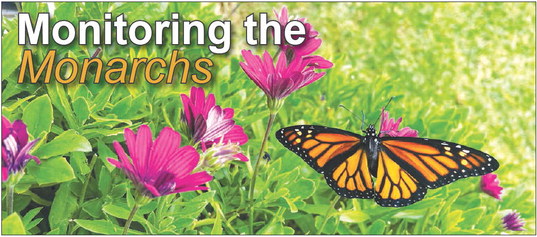Monarchs


Monitoring the
by Donna Gambol
LW Contributor
You see them fluttering about, the regal monarch butterfly. Folks this year seem to notice that there are more and more because for the past few years many residents have made an effort to plant and maintain milkweed in their gardens, the only food eaten by the monarch caterpillar.
The milkweed plant is not particularly attractive, but it is not offensive either and will often find a rooting source on the edges of gardens. Some folks have cultivated it more centrally. Cultivating it, cutting it back during the winter months, and encouraging additional plantings all are contributing to a resurgence of the monarch butterfly.
The western monarch population, which overwinters in California as part of its international migration, has suffered a 99% decline over the past two decades, according to the Center for Biological Diversity. Milkweed, an unassuming green leafy plant with small, round blooms, largely sustains monarchs during their important caterpillar stage. Only after spending 10-14 days gorging on milkweed will a monarch caterpillar begin to form its chrysalis.
To support local monarch populations, it is important to plant native species of the plant. Often the plants sold at Home Depot and other retailers are not native. One excellent source is Tree of Life nursery in San Juan Capistrano, which specializes in native plants.
Those who grow the common tropical milkweed (Asclepias curassavica) should trim it back in late fall to near the ground to encourage new growth and to force the monarchs to migrate to their winter migration grounds.
Not to worry about those hungry caterpillars, after they completely strip a milkweed plant in the springtime, more leaves will regenerate and a second generation of butterflies will emerge in late summer.
This past summer Midge Bash of Mutual 14 has been helping to educate folks about the monarch butterfly. She has been clipping stems of the milkweed laden with eggs, encouraging caterpillar growth, keeping the chrysalises protected from birds in special cage habitats until the butterflies emerge.
Once the butterfly emerges, it takes a few hours for its wings to open and descend. Then it is ready for release.

Dana Westmoreland of Mutual 14 holds a monarch butterfly.

Stephanie Matthews of Mutual 14 displays a butterfly on a rose.

The monarch chrysalises are protected from predatorswith mesh netting.


